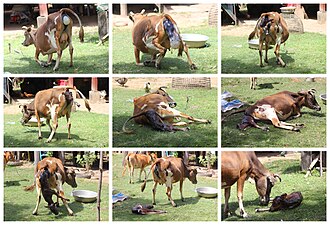Cattle





==Cattle ==

Cattle (Bos taurus) are large domesticated ungulates. They are a prominent modern member of the subfamily Bovinae, are the most widespread species of the genus Bos, and are most commonly classified collectively as Bos taurus.
Cattle are raised as livestock for meat (beef and veal), as dairy cattle for milk and other dairy products, and as draught animals (oxen or bullocks that pull carts, plows, and other implements). Other products include leather and dung for manure or fuel. In some regions, such as parts of India, cattle have significant religious meaning.
History[edit]
Cattle were originally identified as three separate species: Bos taurus, the European or "taurine" cattle (including similar types from Africa and Asia); Bos indicus, the zebu; and the extinct Bos primigenius, the aurochs. The aurochs is ancestral to both zebu and taurine cattle. Modern genetic studies have shown that taurine and zebu cattle were both likely domesticated from the aurochs in the Near East and the Indian subcontinent, respectively.
Breeds[edit]
There are over 1,000 recognized breeds of cattle. These breeds are often classified into two main types: dairy cattle and beef cattle. Some well-known dairy breeds include the Holstein, Jersey, and Guernsey. Popular beef breeds include the Angus, Hereford, and Charolais.
Anatomy and Physiology[edit]
Cattle are ruminants, meaning they have a specialized stomach with four compartments: the rumen, reticulum, omasum, and abomasum. This complex stomach structure allows them to digest fibrous plant material efficiently. Cattle have a unique dental structure with a dental pad instead of upper front teeth, which helps them grasp and tear grass.
Behavior[edit]
Cattle are social animals and form herds for protection and social interaction. They communicate through vocalizations, body language, and chemical signals. Cattle have a well-developed sense of smell and can detect odors up to six miles away.
Economic Importance[edit]
Cattle play a crucial role in agriculture and the global economy. They provide essential products such as meat, milk, and leather. The dairy industry relies heavily on cattle for milk production, which is processed into various dairy products like cheese, butter, and yogurt. The beef industry is a significant source of protein for human consumption.
Cultural Significance[edit]
In many cultures, cattle hold significant cultural and religious importance. In Hinduism, cattle, especially cows, are considered sacred and are protected by law in many parts of India. In other cultures, cattle are symbols of wealth and status.
Health and Diseases[edit]
Cattle are susceptible to various diseases, including bovine spongiform encephalopathy (BSE), commonly known as mad cow disease, foot-and-mouth disease, and bovine tuberculosis. Proper management and veterinary care are essential to maintain the health of cattle herds.
See Also[edit]
References[edit]
<references group="" responsive="1"></references>
External Links[edit]

This article is a agriculture stub. You can help WikiMD by expanding it!
Ad. Transform your life with W8MD's Budget GLP-1 injections from $75


W8MD offers a medical weight loss program to lose weight in Philadelphia. Our physician-supervised medical weight loss provides:
- Weight loss injections in NYC (generic and brand names):
- Zepbound / Mounjaro, Wegovy / Ozempic, Saxenda
- Most insurances accepted or discounted self-pay rates. We will obtain insurance prior authorizations if needed.
- Generic GLP1 weight loss injections from $75 for the starting dose.
- Also offer prescription weight loss medications including Phentermine, Qsymia, Diethylpropion, Contrave etc.
NYC weight loss doctor appointmentsNYC weight loss doctor appointments
Start your NYC weight loss journey today at our NYC medical weight loss and Philadelphia medical weight loss clinics.
- Call 718-946-5500 to lose weight in NYC or for medical weight loss in Philadelphia 215-676-2334.
- Tags:NYC medical weight loss, Philadelphia lose weight Zepbound NYC, Budget GLP1 weight loss injections, Wegovy Philadelphia, Wegovy NYC, Philadelphia medical weight loss, Brookly weight loss and Wegovy NYC
|
WikiMD's Wellness Encyclopedia |
| Let Food Be Thy Medicine Medicine Thy Food - Hippocrates |
Medical Disclaimer: WikiMD is not a substitute for professional medical advice. The information on WikiMD is provided as an information resource only, may be incorrect, outdated or misleading, and is not to be used or relied on for any diagnostic or treatment purposes. Please consult your health care provider before making any healthcare decisions or for guidance about a specific medical condition. WikiMD expressly disclaims responsibility, and shall have no liability, for any damages, loss, injury, or liability whatsoever suffered as a result of your reliance on the information contained in this site. By visiting this site you agree to the foregoing terms and conditions, which may from time to time be changed or supplemented by WikiMD. If you do not agree to the foregoing terms and conditions, you should not enter or use this site. See full disclaimer.
Credits:Most images are courtesy of Wikimedia commons, and templates, categories Wikipedia, licensed under CC BY SA or similar.
Translate this page: - East Asian
中文,
日本,
한국어,
South Asian
हिन्दी,
தமிழ்,
తెలుగు,
Urdu,
ಕನ್ನಡ,
Southeast Asian
Indonesian,
Vietnamese,
Thai,
မြန်မာဘာသာ,
বাংলা
European
español,
Deutsch,
français,
Greek,
português do Brasil,
polski,
română,
русский,
Nederlands,
norsk,
svenska,
suomi,
Italian
Middle Eastern & African
عربى,
Turkish,
Persian,
Hebrew,
Afrikaans,
isiZulu,
Kiswahili,
Other
Bulgarian,
Hungarian,
Czech,
Swedish,
മലയാളം,
मराठी,
ਪੰਜਾਬੀ,
ગુજરાતી,
Portuguese,
Ukrainian